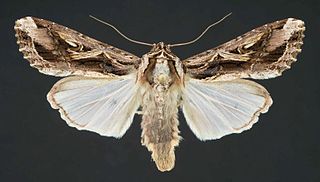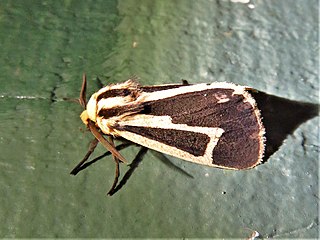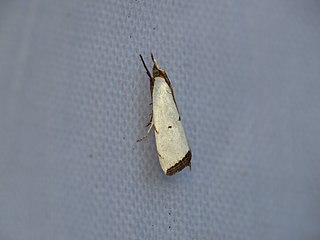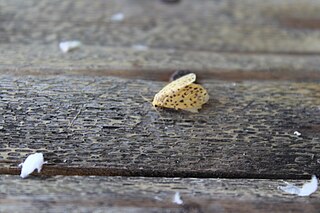
Orthonama vittata, the oblique carpet, is a moth of the family Geometridae. The species was first described by Moritz Balthasar Borkhausen in 1794. It is found throughout the Palearctic realm.
Ercta is a genus of moths of the family Crambidae.

Orthonama is a genus of the geometer moth family (Geometridae). It belongs to the tribe Xanthorhoini of the "carpet" subfamily (Larentiinae). Nycterosea is usually included here by modern authors, but may in fact be distinct enough to warrant recognition as an independent genus. The genus was erected by Jacob Hübner in 1825.

Hypocala deflorata is a moth of the family Erebidae. It was first described by Johan Christian Fabricius in 1794. It is widespread from India, Sri Lanka to Africa and to Australia and many Pacific islands. Records include China, Borneo, Queensland, Vanuatu, New Caledonia, Rotuma, Fiji, Samoa, Hawaii, Norfolk Island and New Zealand.

Simplicia cornicalis is a litter moth of the family Erebidae. The species was first described by Johan Christian Fabricius in 1794. It is found in south-eastern Asia and the Pacific. Records include New Caledonia, Réunion, Thailand, Fiji, Hawaii, India, Sri Lanka, the Society Islands, as well as New South Wales and Queensland in Australia. It is an introduced species in southern Florida and Louisiana in the United States.

Spodoptera dolichos, the dolichos armyworm moth or sweetpotato armyworm moth, is a moth of the family Noctuidae. The species was first described by Johan Christian Fabricius in 1794. It is found from the southern United States, south through Costa Rica to South America, as far south as Argentina. In the United States, it may occur as far north as Kentucky and Maryland.
Scopula umbilicata, the swag-lined wave moth, is a moth of the family Geometridae. The species was first described by Johan Christian Fabricius in 1794. It is found from the southern part of the United States to South America and the West Indies.

Apantesis vittata, the banded tiger moth, is a moth of the family Erebidae. It was described by Johan Christian Fabricius in 1787. It is found in the United States from Maryland to Florida, west to Kentucky and Louisiana.

Synchlora herbaria is a moth in the family Geometridae first described by Johan Christian Fabricius in 1794. It is found in Florida, Cuba, Hispaniola, Puerto Rico, the Bahamas, Antigua, Dominica and the Virgin Islands.

Haplotinea insectella, the drab clothes moth or fungus grain moth, is a moth of the family Tineidae. It was described by Johan Christian Fabricius in 1794. It is found in all of Europe, except Ireland, the Iberian Peninsula and the western and southern part of the Balkan Peninsula. It is also found in North America. The species is often found in warehouses, granaries, mills and farm buildings.

Argyria lacteella, the milky urola moth, is a moth in the family Crambidae. It was described by Johan Christian Fabricius in 1794. It is found in North America, from Maryland south to Florida and west to Texas. In the south, the range extends through Costa Rica to Brazil. It is also found on Cuba, Puerto Rico and Bermuda.
Achyra bifidalis is a moth in the family Crambidae. It was described by Johan Christian Fabricius in 1794. It is found from the southern United States south through Mexico to Brazil and Argentina. It is also found in the West Indies.
Lygropia tripunctata, the sweetpotato leafroller, is a moth in the family Crambidae. It was described by Johan Christian Fabricius in 1794. It is found in the United States, where it has been recorded from Texas to South Carolina and Florida. It is also found from the West Indies and Central America to Brazil.

Palpita annulata is a moth in the family Crambidae. It was described by Johan Christian Fabricius in 1794. It is found in India, Sri Lanka, Myanmar, China, Taiwan and Queensland, Australia.
Parotis marinata is a moth in the family Crambidae. It was described by Johan Christian Fabricius in 1784. It is found in India, Sri Lanka, New Guinea, on the Solomon Islands, the Democratic Republic of the Congo, South Africa. and Australia.

Polygrammodes eleuata, the red-spotted sweetpotato moth or many-spotted moth, is a moth in the family Crambidae. It was described by Johan Christian Fabricius in 1777. It is found in Central and South America, on the Antilles and in the southern United States, where it has been recorded from Florida.










